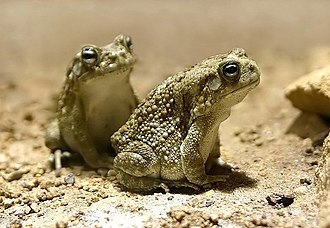Difference between revisions of "AY Honors/Species Account/Amietophrynus regularis/es"
From Pathfinder Wiki
< AY HonorsAY Honors/Species Account/Amietophrynus regularis/es
(Created page with "Libro de Respuestas de Especialidades JA/Cuenta de Especie/Amietophrynus regularis") |
(Created page with "species id/es |common_name = Sapo común africano |latin_name = Amietophrynus regularis |image = Pantherkroete-04.jpg |description = Esta es la rana o sapo más común en Egip...") |
||
| Line 2: | Line 2: | ||
{{ | {{ | ||
| − | species id | + | species id/es |
| − | |common_name= | + | |common_name = Sapo común africano |
| − | |latin_name= Amietophrynus regularis | + | |latin_name = Amietophrynus regularis |
| − | |image=Pantherkroete-04.jpg | + | |image = Pantherkroete-04.jpg |
| − | |description= | + | |description = Esta es la rana o sapo más común en Egipto, y en gran parte de África. El sapo común africano es un gran sapo robusto con una piel verrugosa. Los machos crecen hasta una longitud de 62 a 91 mm y las hembras llegan a 70 a 130 mm. Las glándulas paratiroides son grandes y de forma paralela o en forma de riñón y el macho tiene un solo saco vocal bajo la barbilla. La superficie dorsal es marrón oliva oscuro con manchas oscuras en la parte posterior, muchas veces de forma simétrica, y en los animales más jóvenes hay una banda pálida a lo largo de la columna vertebral. Hay manchas oscuras más pequeñas en el labio superior y los párpados, y las verrugas en los flancos usualmente están separadas por marcas oscuras. Las gargantas de los machos son de color negro y las partes inferiores de ambos sexos son de color blanco a beige. La llamada es un traqueteo formado por dos pulsos y una duración de aproximadamente un 0.9 segundo. |
'''Habitat:''' both moist and dry savanna, montane grassland, forest margins, and agricultural habitats. It is often found near rivers, where it also breeds. It is not a forest species but in the forest zone it can still be found in degraded habitats and towns (including gardens). <br> | '''Habitat:''' both moist and dry savanna, montane grassland, forest margins, and agricultural habitats. It is often found near rivers, where it also breeds. It is not a forest species but in the forest zone it can still be found in degraded habitats and towns (including gardens). <br> | ||
Revision as of 04:30, 28 May 2015
| Amietophrynus regularis (Sapo común africano) | |
|---|---|
|
Descripción: Esta es la rana o sapo más común en Egipto, y en gran parte de África. El sapo común africano es un gran sapo robusto con una piel verrugosa. Los machos crecen hasta una longitud de 62 a 91 mm y las hembras llegan a 70 a 130 mm. Las glándulas paratiroides son grandes y de forma paralela o en forma de riñón y el macho tiene un solo saco vocal bajo la barbilla. La superficie dorsal es marrón oliva oscuro con manchas oscuras en la parte posterior, muchas veces de forma simétrica, y en los animales más jóvenes hay una banda pálida a lo largo de la columna vertebral. Hay manchas oscuras más pequeñas en el labio superior y los párpados, y las verrugas en los flancos usualmente están separadas por marcas oscuras. Las gargantas de los machos son de color negro y las partes inferiores de ambos sexos son de color blanco a beige. La llamada es un traqueteo formado por dos pulsos y una duración de aproximadamente un 0.9 segundo.
Habitat: both moist and dry savanna, montane grassland, forest margins, and agricultural habitats. It is often found near rivers, where it also breeds. It is not a forest species but in the forest zone it can still be found in degraded habitats and towns (including gardens).
|
Amietophrynus regularis
|

